Buckland's Complete
Gypsy Fortuneteller
Llewellyn Publications
![[Front of Box]](buckbx2.gif)
![[Back of Cards]](buckbk2.gif) This
deck is but a part of the greater Complete Gypsy Fortuneteller kit, which
includes the deck, an instructional pamphlet, a layout mat, and a book
on a wide variety of fortune-telling methods. The deck is obviously the
central theme, but the book offers a wealth of tangential information.
The cards are similar in organization to the Tarot, which is but a distant
ancestor. The deck consists of 52 standard cards called the Little Book
(Tarno Lil), and 22 other cards called the Big Book (Boro Lil).
The Boro Lil bears only a superficial resemblance to the Major Arcana from
which it descended, being instead a set of special cards with meanings
particular to a family or tradition, with great variation across all readers.
This set is the Buckland family traditional set, as interpreted by Ray
Buckland.
This
deck is but a part of the greater Complete Gypsy Fortuneteller kit, which
includes the deck, an instructional pamphlet, a layout mat, and a book
on a wide variety of fortune-telling methods. The deck is obviously the
central theme, but the book offers a wealth of tangential information.
The cards are similar in organization to the Tarot, which is but a distant
ancestor. The deck consists of 52 standard cards called the Little Book
(Tarno Lil), and 22 other cards called the Big Book (Boro Lil).
The Boro Lil bears only a superficial resemblance to the Major Arcana from
which it descended, being instead a set of special cards with meanings
particular to a family or tradition, with great variation across all readers.
This set is the Buckland family traditional set, as interpreted by Ray
Buckland.
The Boro Lil in this set contains 22 numbered cards, each depicting
and representing facets and circumstances in everyday life, such as Dancers
(celebration or excitement), Encampment (fruition, encouragement, friends),
Approaching Vardo (news, adventure) and Burning Vardo (endings, new beginnings,
opportunity - see the Chinese glyph for Crisis). The feeling behind the
cards is very similar to the Tarot's Major Arcana, yet without any clear
direct parallels. Nonetheless, it's obvious that they're intended to fill
the same roles, as archetypes. Vardo above, by the way, is the traditional
horse-drawn living quarters of the Romani.
The Tarno Lil is not without its own set of interpretations, usually
with more specific meanings assigned to the cards, defining individuals
and circumstances rather than the long-term and large-scale happenings
in the Boro Lil. The face cards all represent individuals in various relationships
to the querent (the person asking for the reading), and the numerical cards
have events and objects tied to them. While the Boro Lil above has no separate
meaning when a card is inverted, the Tarno Lil does. And as with all divination
systems, you lay the cards out in a pattern on the table and the exact
import of each card is determined from the position in the layout.
The deck comes with a small pamphlet which offers a short history of
cards in the Romani culture, a quick description of the import of all of
the cards, and some sample layouts. The are quick to point out that much
of the reading is subjective, with much discretion given to the sensitivities
of the reader. If it doesn't feel right, it isn't. The history of cards
offered is fascinating, and included below. Whether it's true is guaranteed
to be a point of contention among students of the history of playing cards.
Fortunetelling cards first appeared in Europe during the fourteenth
century in the form of the Tarot deck. Almost certainly they were introduced
by the Gypsies, nomads who had left their native India and roamed - as
they have continued to do to the present day - across Europe and Asia,
living by their wits. Many people believed that these travelers, with their
bright clothing and swarthy features, were descendants of the ancient Egyptians,
or 'Gyptians, this later being shortened to 'Gypsies. It's
no wonder, then, that the fortunetelling cards they carried have come to
be erroneously thought of as originating with the ancient Egyptians.
The Tarot deck consists of 78 cards divided into two parts: the Major
Arcana (22 cards) and the Minor Arcana (56 cards). The Major Arcana is
made up of individual cards each bearing a different scene and set of symbols.
The Minor Arcana is further divided into four suits: Wands, Cups, Pentacles
and Swords. Each suit has an Ace through Ten, plus Page, Knight, Queen
and King. The full deck can be used for reading, or just the Major Arcana
alone.
Over the centuries the Minor Arcana came to be used in games of chance
and eventually developed into today's "poker deck." The suit
of Cups became hearts, Wands became Clubs, Pentacles became Diamonds, and
Swords became Spades. Somewhere along the way, the Knight was discarded,
leaving Page (now "Jack"), Queen and King.
Although today many a Gypsy (or Romani, to use the true name)
reads the Tarot, the majority also read the poker deck - even though there
are only the "pips," with no full scenes to interpret. Over the
past two hundred years or so - especially when Tarot decks have not been
easy to find - some Romani families have designed their own "Major
Arcana" cards to go with the poker deck, thus making up a full deck
(but not quite full, since the Knight was still missing - a total of 74
cards rather than 78). These new "Major Arcana" cards frequently
bore no resemblance to those of the regular Tarot, and even varied greatly
from one Gypsy family to the next.
One such Romani deck is that of the Buckland family of Gypsies, and
it is here presented for the first time ever. It will be seen that even
the Kings and Queens have become Gypsy Kings and Queens.
All images and quoted text © Raymond Buckland 1989, displayed here
for commentary, analysis and appreciation only.
|
Ace of Spades
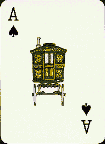
|
Seven of Hearts
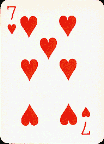
|
Jack of Diamonds
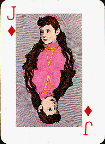
|
|
King of Clubs
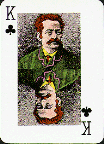
|
Number 3
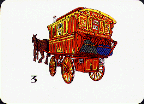
Departing Vardo
|
Number 20
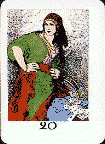
Fortunetelling
|
The cards shown above, of course, have their own special meanings:
Ace of Spades:
Spades seems to be the suit of darkness, despair, and death. Not an
unexpected theme for spades, which has historically been the suit of death.
This may derive from the Swords from which it descended. I am especially
amused that the toll of years has beaten the swords into ploughshares.
The ace signifies, "An emotional relationship that could cause trouble.
Reversed: Unexpected bad news."
Seven of Hearts:
Equally predictable is the identification of hearts with love, friendship
and happiness. And it could be said that the analogous Tarot suit, Cups,
runneth over in this suit. The seven signifies, "Pleasant thoughts.
Tranquility. Reversed: Tedium; weariness; boredom.
Jack of Diamonds:
Diamonds signify, in general, not money but worldliness. This is a refreshingly
broad application, since so often diamonds focus on the narrow pursuit
of money. Here we have purloined letters, intrigue, sex, scandal and business
pursuits. Hopefully not all in the same day. Of the jack, the kit tells
us, "An unfaithful friend or employee. Reversed: Many problems
caused by him/her."
King of Clubs:
Clubs are the suit of the fruits of labor, with such themes as prosperity,
wealth, generosity, debt, and cleverness. Diamonds may be the high life
in the big city, and hearts love and happiness, but clubs are certainly
the community and the family, with contentment more important than power
and joy. Of the king, we read, "A frank, liberal man, fond of serving
his friends. Reversed: He will meet with disappointment."
Boro Lil No. 3:
Boro Lil Trin (which means three), the Departing Vardo, signifies,
"Missed opportunity. Loss; departure. Need to review, to regroup.
Endings." A different culture might say you missed the boat or the
train.
Boro Lil No. 20:
Boro Lil Bish (twenty), Fortunetelling or Dukkerin', reflects,
"Foreseeing. Psychic abilities. Power; control. Mysteries revealed.
Hidden secrets. Initiation. Responsibility."
I won't try to outline any of the layouts given in the pamphlet. Fortunetelling
is an activity I have neither experience nor skill in, and I couldn't
hope to capture the important nuances. Instead, let me spend my closing
words discussing the fascinating book that completes the kit. The Secrets
of Gypsy Fortunetelling, also by Ray Buckland, is much more than an
accompaniment to the deck. It's in fact more often sold separately. Although
it has a section on card reading, describing both Tarot and poker-deck
systems, it describes in some detail a host of other divination systems.
Before everything that follows, think quietly, "according to Ray Buckland."
The four main methods of individual fortunetelling are palmistry, tea
leaves, cartomancy, and crystal reading. After a short but interesting
introduction giving a nutshell history of the Romani and their divination
practices, Buckland offers a wide and detailed introduction to these fields.
These sections cover more than half the book, and are a good start for
anyone wanting to either satisfy their curiosity, or just dive in and practice.
After those, he delves into fortunetelling methods using dice, dominoes,
moles on the skin (in a similar vein as palmistry or phrenology), fire-gazing,
jewelry, sticks and stones, knives and needles, and omens. And he closes
with some advice about how to approach a "cold" reading.
The mechanics he offers are certainly interesting enough to people interested
in divination, but the glimpses he offers into the life and world of the
Romani through the ages, and especially in the time of his grandparents,
are fascinating. Most of the book owes its existence to his grandparents,
who were the first in his family to give up the vardo and move into
a permanent home. They were the last of his family who could really speak
personally about the life of the itinerant Gypsies, and it's knowledge
I'm glad is not lost.
Return to cards page
Send me mail.
![[Front of Box]](buckbx2.gif)
![[Back of Cards]](buckbk2.gif) This
deck is but a part of the greater Complete Gypsy Fortuneteller kit, which
includes the deck, an instructional pamphlet, a layout mat, and a book
on a wide variety of fortune-telling methods. The deck is obviously the
central theme, but the book offers a wealth of tangential information.
The cards are similar in organization to the Tarot, which is but a distant
ancestor. The deck consists of 52 standard cards called the Little Book
(Tarno Lil), and 22 other cards called the Big Book (Boro Lil).
The Boro Lil bears only a superficial resemblance to the Major Arcana from
which it descended, being instead a set of special cards with meanings
particular to a family or tradition, with great variation across all readers.
This set is the Buckland family traditional set, as interpreted by Ray
Buckland.
This
deck is but a part of the greater Complete Gypsy Fortuneteller kit, which
includes the deck, an instructional pamphlet, a layout mat, and a book
on a wide variety of fortune-telling methods. The deck is obviously the
central theme, but the book offers a wealth of tangential information.
The cards are similar in organization to the Tarot, which is but a distant
ancestor. The deck consists of 52 standard cards called the Little Book
(Tarno Lil), and 22 other cards called the Big Book (Boro Lil).
The Boro Lil bears only a superficial resemblance to the Major Arcana from
which it descended, being instead a set of special cards with meanings
particular to a family or tradition, with great variation across all readers.
This set is the Buckland family traditional set, as interpreted by Ray
Buckland.




